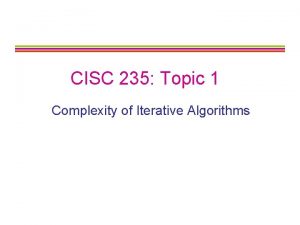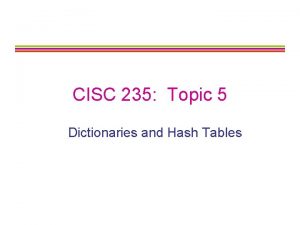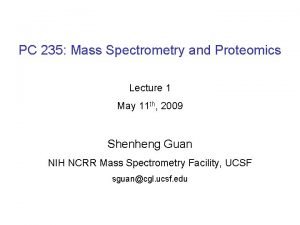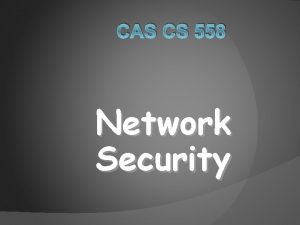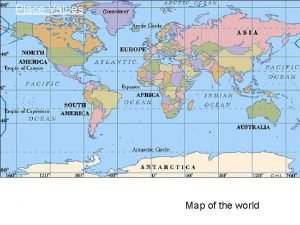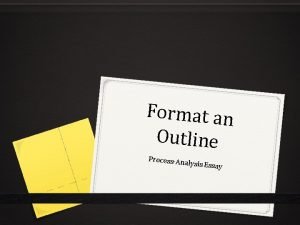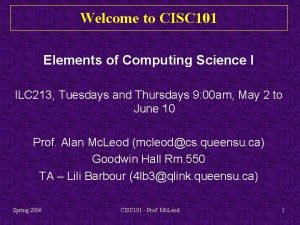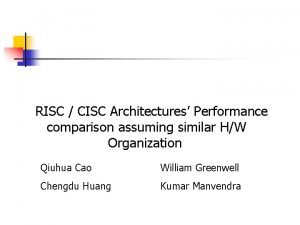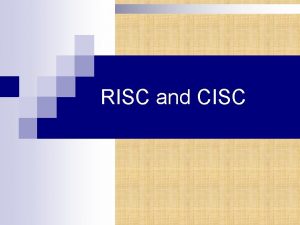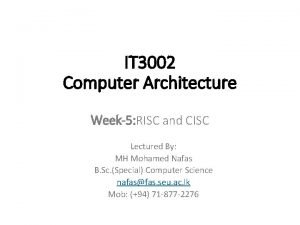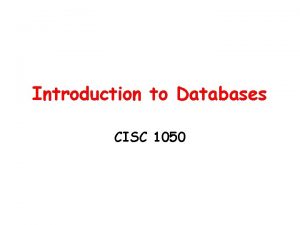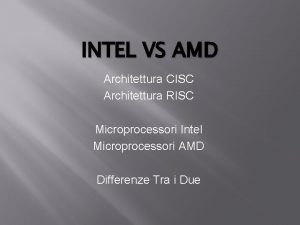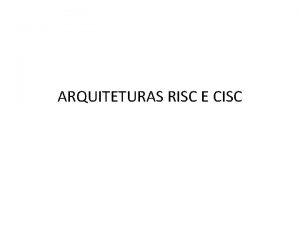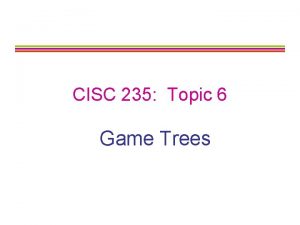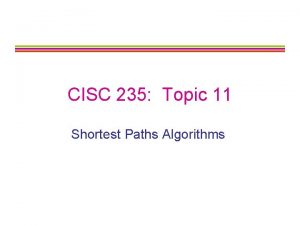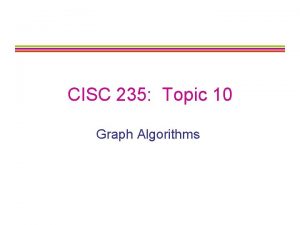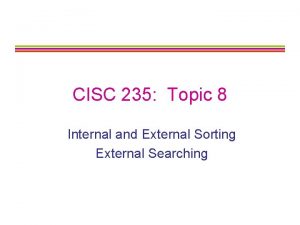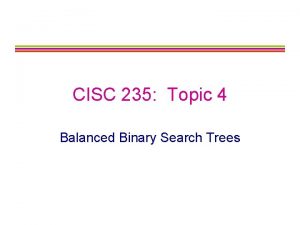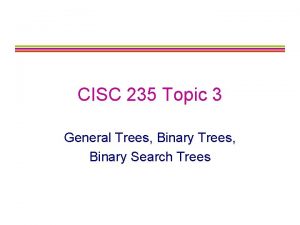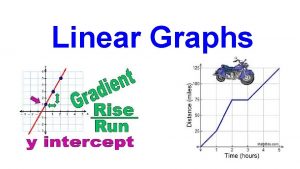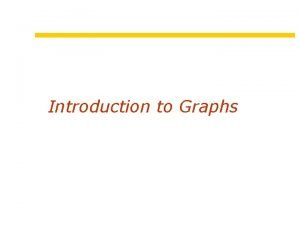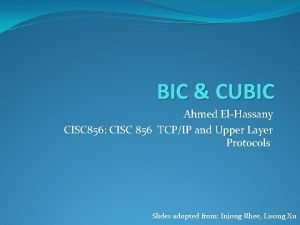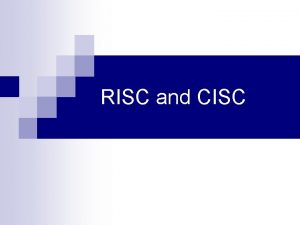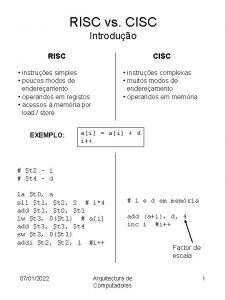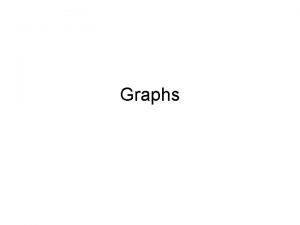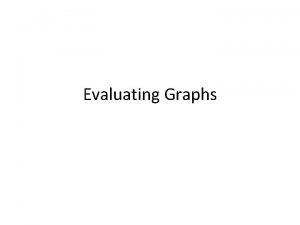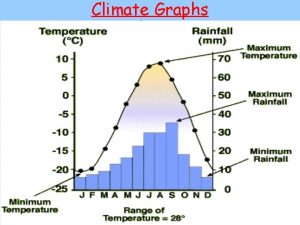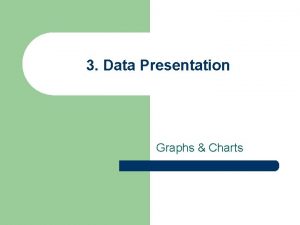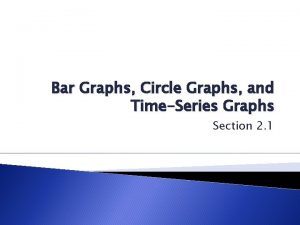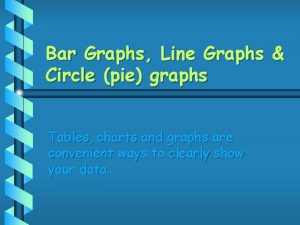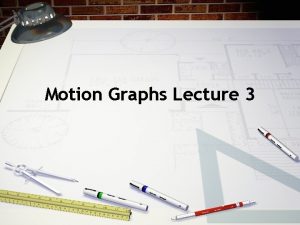CISC 235 Topic 9 Introduction to Graphs Outline





























- Slides: 29

CISC 235: Topic 9 Introduction to Graphs

Outline • • Graph Definition Terminology Representations Traversals CISC 235 Topic 9 2

Graphs A graph G = (V, E) is composed of: V: set of Vertices E: set of edges connecting the vertices in V An edge e = (u, v) is a pair of vertices a b c Example: d V = {a, b, c, d, e} E = {(a, b), (a, c), (a, d), (b, e), (c, d), (c, e), (d, e)} CISC 235 Topic 9 e 3

Example OTT 450 km 90 km TOR 170 km 250 km 100 km KIN COR 100 km 150 km MON 100 km 200 km ROC SYR 100 km CISC 235 Topic 9 4

Terminology An undirected graph has undirected edges. Each edge is associated with an unordered pair. A directed graph, or digraph, has directed edges. Each edge is associated with an ordered pair. A weighted graph is one in TO which the edges are labeled with numeric values. CISC 235 Topic 9 TO Ott Kin MO 300 Ott 300 500 200 MO 5

Undirected Graphs Adjacent (Neighbors): Two vertices connected by an edge are adjacent. Incident: The edge that connects two vertices is incident on both of them. Degree of a Vertex v, deg(v): The number of edges incident on it (loop at vertex is counted twice) CISC 235 Topic 9 6

Directed Graphs Edge (u, v): u is adjacent to v v is adjacent from u deg -(v) : The in-degree of v, the number of edges entering it deg +(v): The out-degree of v, the number of edges leaving it CISC 235 Topic 9 7

Euler & the Bridges of Koenigsberg Can one walk across each bridge exactly once and return to the starting point? CISC 235 Topic 9 8

Eulerian Tour What characteristics are required of an undirected graph for a Eulerian Tour to be possible? CISC 235 Topic 9 9

Terminology A path is a sequence of vertices v 1, v 2, … vk such that vi and vi +1 are adjacent. A simple path is a path that contains no repeated vertices, except for perhaps the first and last vertices in the path. A cycle is a simple path, in which the last vertex is the same as the first vertex. a b a c d c e d abecde a b CISC 235 Topic 9 edc e cdeb a c d b b c e d edce e 10

Terminology A graph is connected if, for any two vertices, there is a path between them. A tree is a connected graph without cycles. A subgraph of a graph G is a graph H whose vertices and edges are subsets of the vertices and edges of G. a b a c b c d e graph G 1 d e graph G 2 a a b b c c e graph G 3 CISC 235 Topic 9 d e graph G 4 11

Terminology a A forest is a graph that is a collection of trees. More simply, it is a graph without cycles. b a c d b c e d e e a b a c c e CISC 235 Topic 9 b d 12

Terminology a b a A complete graph is an undirected graph with every pair of vertices adjacent. a a b c b a d b c c CISC 235 Topic 9 e d 13

Undirected Graphs: Properties a If |E| = |V | -1 and the graph is connected, the graph is a tree b c If |E| < |V | -1, the graph is not connected a If |E| > |V | -1, the graph has at least one cycle d e a b b c CISC 235 Topic 9 d e c d e 14

Undirected Graphs: Properties Let n = |V | Let m = |E | a Sparse Graphs : m is O( n ) Dense Graphs : m is O( n 2 ) d b c e a b c Are complete graphs dense graphs? CISC 235 Topic 9 d e 15

Complete Graphs K 2 a K 3 b K 4 b a a c c b n=2 m=1 n=3 m=3 n=4 m=6 d CISC 235 Topic 9 a K 5 b c d e n=5 m = 10 For Kn, m = n(n-1)/2 16

Representations of Graphs Adjacency List and Adjacency Matrix Representations of an Undirected Graph CISC 235 Topic 9 17

Representations of Graphs Adjacency List and Adjacency Matrix Representations of a Directed Graph CISC 235 Topic 9 18

Graph Implementation Data Store two sets of info: vertices & edges Data can be associated with both vertices & edges A Few Typical Operations adjacent. Vertices( v ) – Return list of adjacent vertices are. Adjacent( v, w ) – True if vertex v is adjacent to w insert. Vertex( o ) – Insert new isolated vertex storing o insert. Edge( v, w, o ) – Insert edge from v to w, storing o at this edge remove. Vertex( v ) – Remove v and all incident edges remove. Edge( v, w ) – Remove edge (v, w) CISC 235 Topic 9 19

Graph Representations Space Analysis Adjacency List: Adjacency Matrix: CISC 235 Topic 9 20

Graph Representations Time Analysis A Few Common Operations Adjacency List Adjacency Matrix are. Adjacent( v, w ) adjacent. Vertices( v ) remove. Edge( v, w ) CISC 235 Topic 9 21

Traversals: Breadth-First Search & Depth-First Search OTT 450 km 90 km TOR 170 km 250 km 100 km KIN COR 100 km 150 km MON 100 km 200 km ROC SYR 100 km CISC 235 Topic 9 22

Breadth-First Search bfs( vertex v ) Create a queue, Q, of vertices, initially empty Visit v and mark it as visited Enqueue ( v, Q ) while not empty( Q ) w = dequeue( Q ) for each unvisited vertex u adjacent to w Visit u and mark it as visited Enqueue( u, Q ) CISC 235 Topic 9 23

Breadth-First Search on an Undirected, Connected Graph CISC 235 Topic 9 24

Depth-First Search dfs( vertex v ) Visit v and mark it as visited for each unvisited vertex u adjacent to v dfs( v ) CISC 235 Topic 9 25

Analysis of BFS & DFS Let n = | V | Let m = | E | CISC 235 Topic 9 26

Application: Java Garbage Collection C & C++: Programmer must explicitly allocate and deallocate memory space for objects - source of errors Java: Garbage collection deallocates memory space for objects no longer used. How? CISC 235 Topic 9 27

Mark-Sweep Garbage Collection Algorithm • Suspend all other running threads. • Trace through the Java stacks of currently running threads and mark as “live” all of the “root” objects. • Traverse each object in the heap that is active, by starting at each root object, and mark it as “live”. • Scan through the entire memory heap and reclaim any space that has not been marked. CISC 235 Topic 9 28

Algorithms Related to BFS & DFS • How could we test whether an undirected graph G is connected? • How could we compute the connected components of G? • How could we compute a cycle in G or report that it has no cycle? • How could we compute a path between any two vertices, or report that no such path exists? • How could we compute for every vertex v of G, the minimum number of edges of any path between s and v? CISC 235 Topic 9 29
 Cisc 235
Cisc 235 Cisc 235
Cisc 235 Example of quote sandwich
Example of quote sandwich Zczc state graph
Zczc state graph Comparing distance/time graphs to speed/time graphs
Comparing distance/time graphs to speed/time graphs Graphs that enlighten and graphs that deceive
Graphs that enlighten and graphs that deceive 5-3 practice polynomial functions
5-3 practice polynomial functions U 235 fission products
U 235 fission products What is 75 rounded to the nearest ten
What is 75 rounded to the nearest ten Pc 235
Pc 235 Add the place value of 3 in 235 to 150
Add the place value of 3 in 235 to 150 Cas cs 235
Cas cs 235 234+34
234+34 Place value and
Place value and Cps 235
Cps 235 General topic example
General topic example /topic/ down
/topic/ down Example of paragraph outline with topic
Example of paragraph outline with topic A topic outline uses
A topic outline uses What is a topic outline
What is a topic outline Full sentence outline example
Full sentence outline example Digital topic outline
Digital topic outline Cisc 101
Cisc 101 Risc vs cisc vs mips
Risc vs cisc vs mips Risc versus cisc
Risc versus cisc Pengertian risc
Pengertian risc Risc disadvantages
Risc disadvantages Cisc2
Cisc2 Cisc 1050
Cisc 1050 Differenza tra intel e amd
Differenza tra intel e amd
